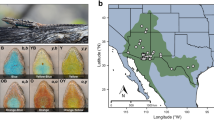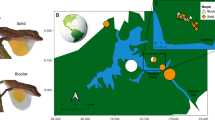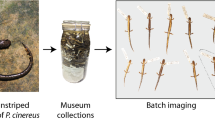Summary
Colonies of the visually polymorphic spider Enoplognatha ovatum have been studied in Nidderdale, Yorkshire, for up to six years. Morph frequencies are found to be stable within colonies between years but to vary between colonies only short distances apart. The stability of the polymorphism argues in favour of powerful selection acting on this character. The nature of the selective factors are unknown but they are not those which influence time of maturity of the spiders or the mature female population size, both of which have varied between years. A genetic basis proposed for the polymorphism is considered and rejected as being incompatible with stable morph frequencies.
Similar content being viewed by others
Article PDF
References
Bristowe, W S. 1931. Notes on the biology of spiders—V. Theridion ovatum Clerck, its habits and varieties. Ann Mag Nat Hist, 8, 466–469.
Bristowe, W S. 1939. The Comity of Spiders 1. Ray Society, London.
Bristowe, W S. 1941. The Comity of Spiders 2. Ray Society, London.
Bristowe, W S. 1958. The World of Spiders. Collins, London.
Ford, E B. 1971. Ecological Genetics. Chapman and Hall, London.
Gerhardt, U. 1921. Vergleichende Studien über die Morphologie de Mänlichen Tasters und die Biologie de Kopulation de Spinnen. Arch Naturg Abt A, 87, 78–247.
Geyer, T. 1967. Polymorphism in the spider Theridion ovatum. Nature Lond, 213, 314.
Levi, H W. 1957. The spider genera Enoplognatha, Theridion and Paidisca in America north of Mexico (Araneae: Theridiidae). Bull Am Mus Nat Hist, 112, 7–8.
Lewontin, R C. 1974. The Genetic Basis of Evolutionary Change. Columbia University Press.
Lewontin, R C, and Cockerham, C C. 1959. The goodness-of-fit test for detecting natural selection in random mating populations. Evolution, 13, 561–564.
Locket, G H, and Millidge, A F. 1953. British Spiders 2. Ray Society, London.
Locket, G H, Millidge, A F. 1974. British Spiders 3. Ray Society, London.
Nielsen, E. 1932. The Biology of Spiders. Copenhagen.
Seligy, V L. 1969. Biochemical aspects of the pigment variation in the spider Enoplognatha ovatum (Clerck). CanadJ Zool, 47, 1103–1105.
Seligy, V L. 1971. Postembryonic development of the spider Enoplognatha ovatum (Clerck). Zool J Linn Soc, 50, 21–31.
Tweedie, M W F. 1970. A case of balanced polymorphism in a spider. Entomologists' Gazette, 21, 50.
Workman, P L, and Niswander, J D. 1970. Population studies on southwestern Indian Tribes. II. Local genetic differentiation in the Papago. Amer J Hum Genet, 22, 24–49.
Author information
Authors and Affiliations
Rights and permissions
About this article
Cite this article
Oxford, G. The colour polymorphism in Enoplognatha ovatum (Clerck) (Araneae: Theridiidae)—Temporal stability and spatial variability. Heredity 36, 369–381 (1976). https://doi.org/10.1038/hdy.1976.44
Received:
Issue date:
DOI: https://doi.org/10.1038/hdy.1976.44
This article is cited by
-
Visible morph-frequency variation in allopatric and sympatric populations of two species of Enoplognatha (Araneae: Theridiidae)
Heredity (1991)
-
Maintaining a happy face: stable colour polymorphism in the spider Theiridion grallator (Araneae, Theridiidae)
Heredity (1990)
-
What makes a happy face? Determinants of colour pattern in the Hawaiian happy face spider Theridion grallator (Araneae, Theridiidae)
Heredity (1989)
-
Geographical distribution of phenotypes regulating pigmentation in the spider Enoplognatha ovata (Clerck) (Araneae: Theridiidae)
Heredity (1985)
-
Genetics of colour and its regulation during development in the spider Enoplognatha ovata (Clerck) (Araneae: Theridiidae)
Heredity (1983)



